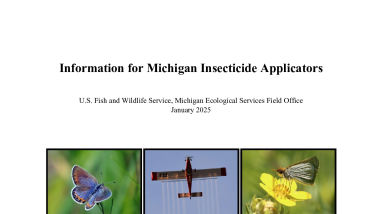
The purpose of this document is to provide a resource about sensitive insect species for insecticide applicators in Michigan. Insect species are critical for a healthy ecosystem. Insects pollinate fruits, flowers, and vegetables, decompose organic waste so nutrients can be reused by plants, and are integral to nearly all food webs. Consequently, it is very important to protect our native insect species, including threatened and endangered insects. When planning an application, applicators must comply with state and federal laws, including the Endangered Species Act and the Bald and Golden Eagle Protection Act. Many insecticide labels also have legally binding restrictions controlling their use in areas with sensitive species or specific types of habitats. Applicators can use this resource to obtain information to avoid impacting federally listed insect species. This information is specific to insect species listed as threatened or endangered under the federal Endangered Species Act. Separate from federally listed species, information and voluntary conservation measures are provided for additional insects of special conservation concern.


